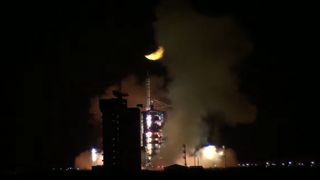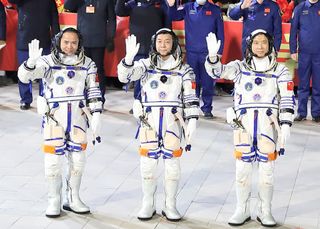China launches 3 astronauts to Tiangong space station for 1st crew handover
The Shenzhou 15 mission will see Tiangong briefly host six astronauts.
China's fourth crew has reached the nation's newly completed Tiangong space station.
A Long March 2F rocket topped with the Shenzhou 15 spacecraft lifted off from Jiuquan Satellite Launch Center in the Gobi Desert today (Nov. 29) at 10:08 a.m. EST (1508 GMT; 11:08 p.m. local time). Spacecraft separation occurred some 10 minutes later.
Fei Junlong (the mission commander), Deng Qingming and Zhang Lu — who were unveiled as the Shenzhou 15 crew just yesterday (Nov. 28) — arrived at Tiangong today at 4:42 p.m. EST (2142 UTC), Chinese space officials announced.
Related: The latest news about China's space program

The Shenzhou 15 mission marks the start of full operations aboard Tiangong, with the trio lined up to conduct more than 100 experiments using 24 specially designed science cabinets installed in the new Wentian and Mengtian modules.
Fei, Deng and Zhang were greeted on Tiangong by the Shenzhou 14 crew — Chen Dong, Liu Yang and Cai Xuzhe — who have spent the past half year in space helping construct the space station. The three new astronauts will take control of the completed, T-shaped Tiangong space station, which received its second and third modules in recent months.
Fei, 57, was selected as one of China's first-generation astronauts in January 1998 and made his first, and so far only, trip to space in 2005 as commander of the five-day-long Shenzhou 6 mission. He is returning to space after 17 years.
Get the Space.com Newsletter
Breaking space news, the latest updates on rocket launches, skywatching events and more!
Deng, 56, is the last active member of the first generation of astronauts to get his first ride into outer space. The third crew member, Zhang Lu, 46, is part of China’s second batch of astronauts, which were selected in May 2010. He is also making his first trip to space, following 12 years of training. Zhang also says he intends to sing in space.

"Although we are the oldest crew in terms of average age, we're confident in our capabilities, as we are still in the 'state of youth,'" Fei said during a Nov. 28 press conference.
"Seventeen years ago, I was on the Shenzhou 6 mission. Even now I'm still excited when I recall those vivid memories. Today I'm extremely proud and excited to go to space again for my country," Fei added.
On Nov. 12, China launched the Tianzhou 5 cargo spacecraft, which delivered around 11,000 pounds (5,000 kilograms) of goods and materials to support the Shenzhou 15 crew for their mission.
The space freighter also carried 3,080 pounds (1,400 kg) of propellant to help the space station maintain its orbit.
Meanwhile, the Shenzhou 14 crewmates will be preparing for their journey home, after overseeing the arrival of two new modules and conducting three spacewalks and other activities. They are expected to touch down near the Jiuquan launch center in early December.
Shenzhou 15 is the final mission of 11 launches planned to construct Tiangong and bring it to full operation. The first saw the launch of the Tianhe core module in April 2021, just under 18 months ago.
Thousands of institutions and companies, as well as researchers and engineers, were involved in the constructive work, Ji Qiming, assistant to the director of the China Manned Space Agency (CMSA), told the press on Monday (Nov. 28). Ji added that the project has exhibited the great synergy of the Chinese people.
China's completed Tiangong station is about 20% as massive as the International Space Station (ISS), according to Chinese space officials. The country aims to keep it permanently occupied for at least a decade and is looking to develop commercial and tourist missions to the orbital outpost.
Tiangong could become the only crewed space station in orbit after the ISS is decommissioned around the end of the decade.
Editor's note: This story was updated at 7 p.m. EST on Nov. 29 with news of Shenzhou 15's arrival at the Tiangong space station.
Follow us on Twitter @Spacedotcom or on Facebook.
Join our Space Forums to keep talking space on the latest missions, night sky and more! And if you have a news tip, correction or comment, let us know at: community@space.com.

Andrew is a freelance space journalist with a focus on reporting on China's rapidly growing space sector. He began writing for Space.com in 2019 and writes for SpaceNews, IEEE Spectrum, National Geographic, Sky & Telescope, New Scientist and others. Andrew first caught the space bug when, as a youngster, he saw Voyager images of other worlds in our solar system for the first time. Away from space, Andrew enjoys trail running in the forests of Finland. You can follow him on Twitter @AJ_FI.
